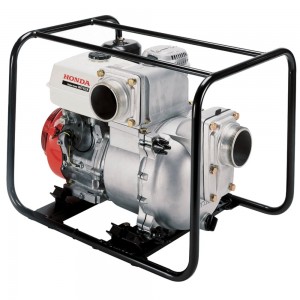 Even when backed by Honda’s legendary reliability and a strictly-followed maintenance schedule, problems can arise that can keep the WT40X from working correctly. Fortunately, many common problems are easy to fix.
Even when backed by Honda’s legendary reliability and a strictly-followed maintenance schedule, problems can arise that can keep the WT40X from working correctly. Fortunately, many common problems are easy to fix.
Engine Won’t Start
Check the controls: The fuel valve and ignition switch should both be set to “On.” If the engine is cold, the choke should be closed.
Check the fuel tank: The tank may be empty, or it could be filled with old fuel. In the latter case, drain the tank and carburetor and fill the tank with fresh gasoline. See “Draining Fuel From the Pump” below.
Check the oil: This engine comes equipped with Honda’s Oil Alert system. If the oil level is too low, it will automatically shut off the engine to prevent damage from a lack of lubrication. Check the oil plug for tightness, then add oil until it reaches the top of the filler neck.
Inspect the spark plug: If the plug is wet from flooding, dry it off and start the engine with the throttle in the “Fast” position. If the plug is fouled or improperly gapped, clean it and adjust the electrode. The electrode gap should be between 0.029 and 0.031 inches (0.7-0.8 mm.) If the plug has been damaged, replace it.
Engine Lacks Power
Check the air filter: Excessive dirt or damage can keep enough air from reaching the engine. Clean or replace as necessary.
Check the fuel: Old fuel that hasn’t been treated can prevent the engine from running at full power. Drain the tank and carburetor, then fill the tank with fresh gas. See “Draining Fuel From the Pump” below.
Nothing Coming Out of the Pump Output
Check the pump chamber: Was it primed before starting the engine? Shut off the engine and fill the priming chamber, located next to the discharge opening, with fresh water. Restart the motor and see if this solved the problem.
Check the suction hose: If the hose has collapsed or has cuts or punctures, it will need to be replaced. The strainer needs to be completely underwater and the connector at the pump housing needs to be air-tight. The strainer may also be clogged and needs to be cleared of debris.
Measure the suction and discharge head: Too much total head or too much suction head can keep the pump from moving water. See “Measuring and Setting Pump Head” below.
Check the engine: See the steps above for diagnosing low engine power.
Low Pump Output
Check the suction hose: If the hose is too small, has collapsed or has been damaged in some way, it can restrict flow to the pump. Check the connector between the hose and pump housing for air leaks, and ensure there isn’t debris blocking the strainer.
Check the discharge hose: Replace the hose if it has been damaged, or the hose is too long or is too small in diameter.
Check the head: Too much head or too much suction head can limit pump capacity. See “Measuring and Setting Pump Head” below.
Check the engine: See the section above on low engine power.
Measuring and Setting Pump Head
Both the suction port and discharge port are 100 mm (3.9 in) in diameter. Ideally, the hoses should match the sizes of these ports. Maximum head, the height the water is pumped, is about 100 feet (30 meters,) but decreasing the head drastically increases pumping capacity. At 58 feet (17.5 meters,) the pump can move as much as 320 gallons (1,200 liters) of water per minute, while moving water from one place to another without an elevation change doubles output to 640 GPM (2,400 LPM.)
Pumping water to the pump takes more power than pushing it out, so placing the pump closer to the surface of the water being moved will improve performance.
Draining Fuel from the Pump
To drain fuel from the carburetor and fuel tank, begin by setting the fuel lever to “Off.” Place an approved gasoline container with a funnel in the opening below the carburetor. Remove the drain bolt on the bottom left of the carburetor and the sediment cup to the right of the drain bolt. Set the fuel lever to “On.” The contents of the carburetor and fuel tank will flow out of these two openings. Once the fuel has drained, reinstall the drain bolt and sediment cup.
Where to buy Honda Pump parts
Figured out the problem with the pump, but need parts to get it fixed? www.hondalawnparts.com can get you whatever you need from hoses to clamps to spark plugs.
